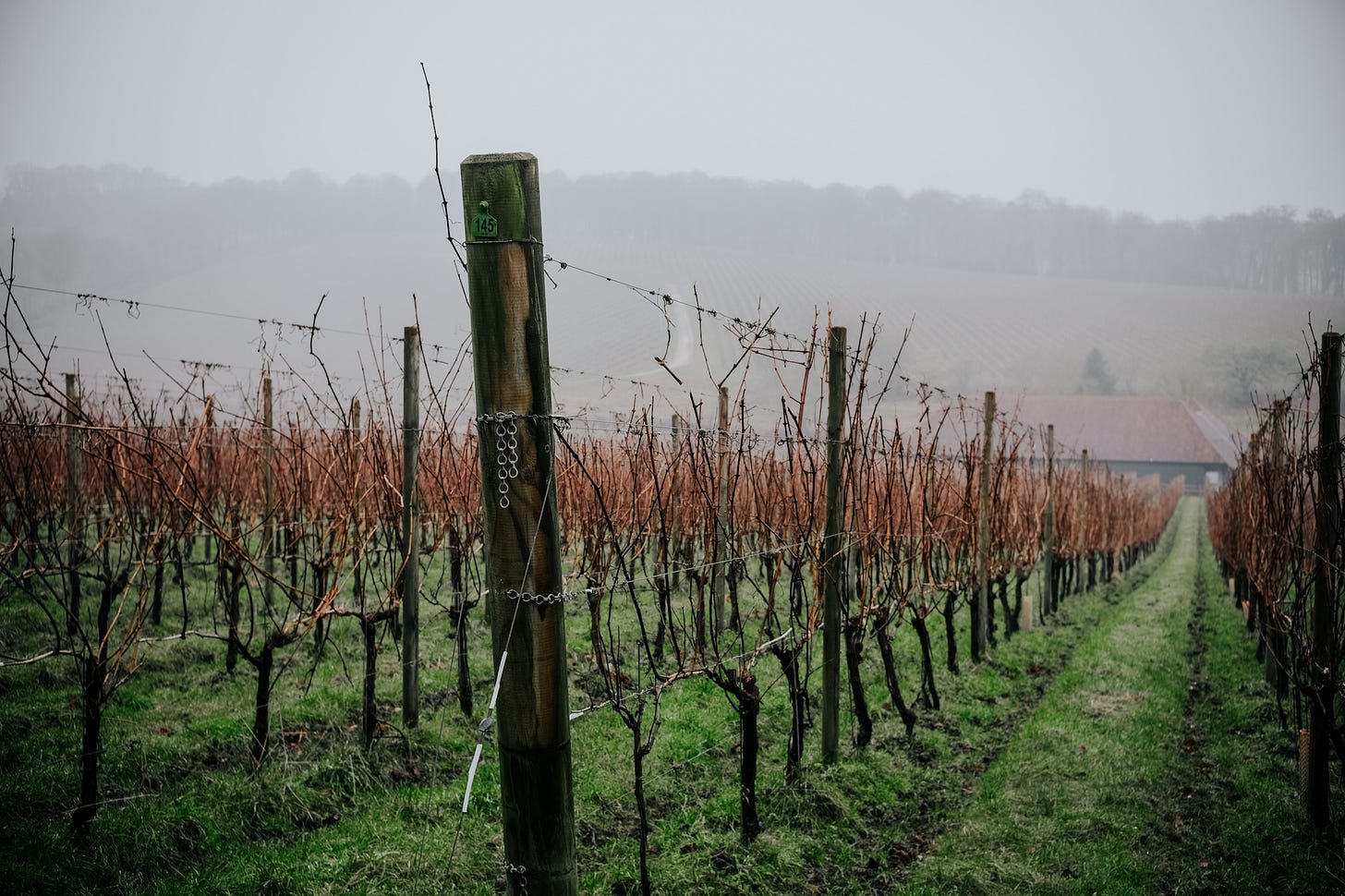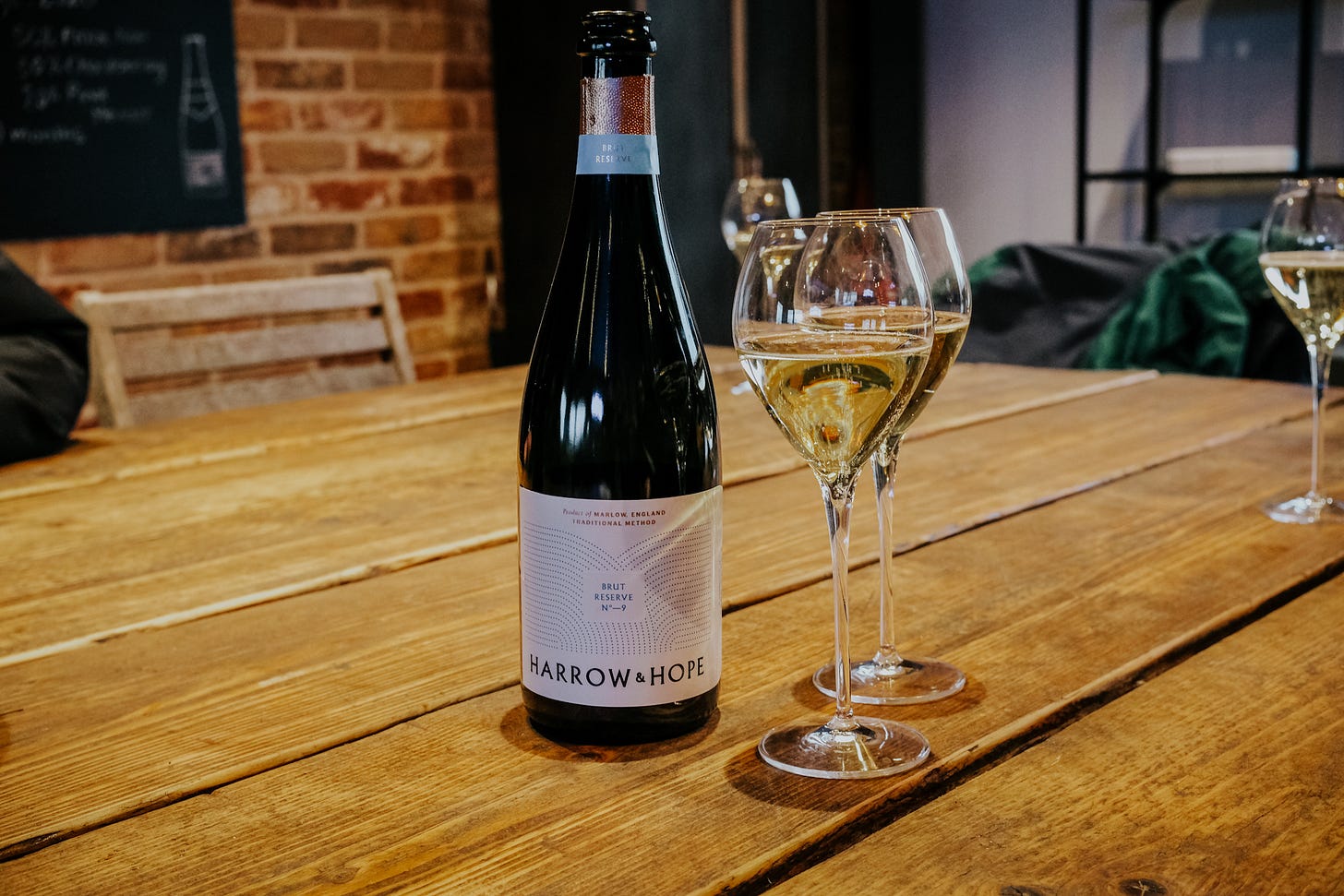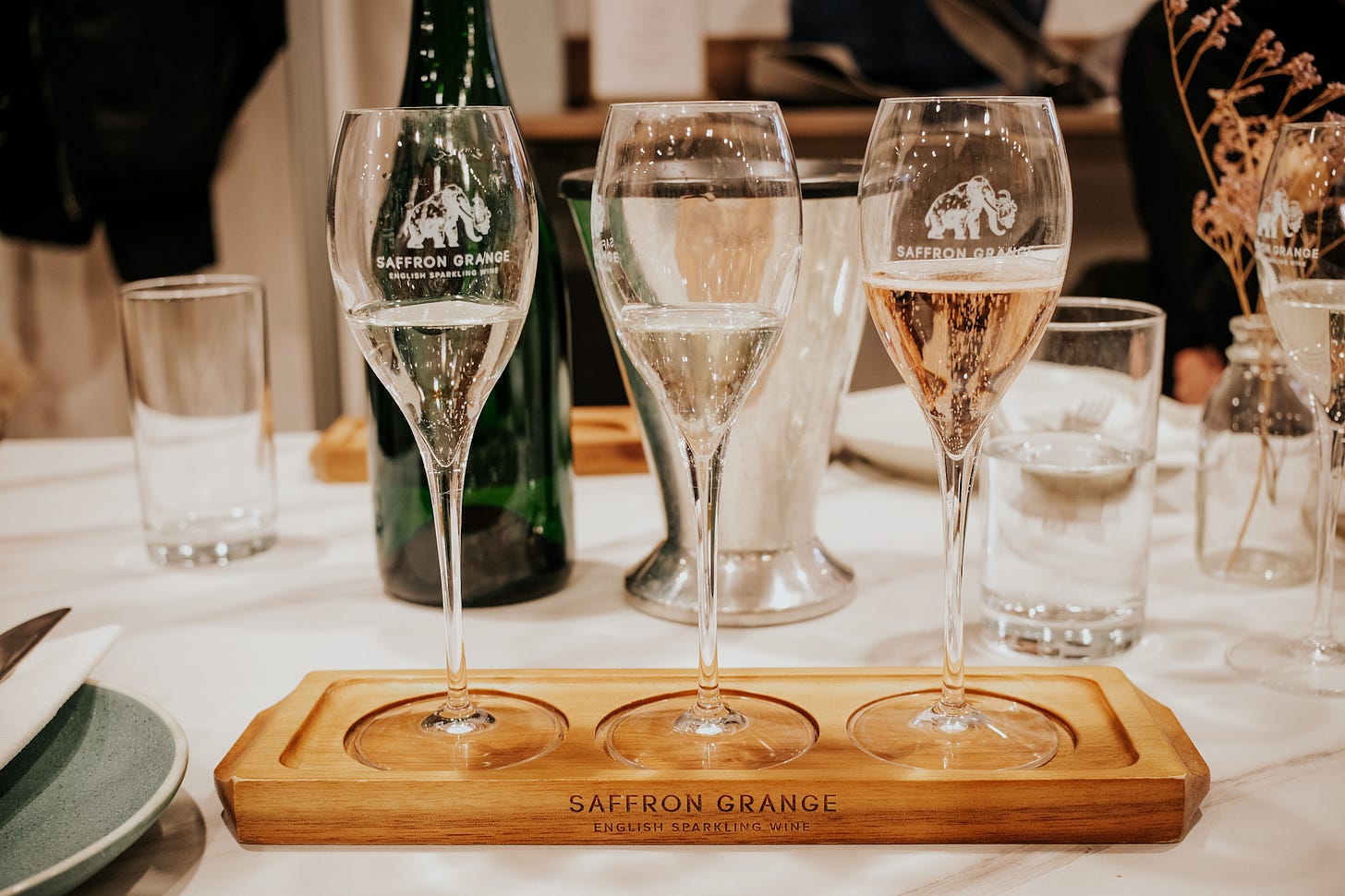UK vineyard tour: part one
A week long road trip around southern England…and lots of sparkling wine.
The English countryside is just as charming as you would suspect. Cute cottages, lots of sheep and horses, pubs covered in brick and climbing ivy, and rolling slopes with rows upon rows of vines. I road tripped this week across southern England with my class at Le Cordon Bleu as we explored eight different wineries. February might seem like an odd time to visit vineyards; the vines are bare and there isn’t much tourist activity. But there’s still a lot happening.
Pruning season is well underway as experts trim the vines to find perfect shoots. They look at the previous year’s shoots and choose what will serve as the main shoots for the upcoming growing season, then prune the rest away. It might seem counterintuitive…why prune the vines when you have a lot of them? (More vines means more grapes and then more wine, right?) It’s an important tactic for making sure your wine is high quality. If a vine’s yield is too high, the energy coming from the root will be divided amongst all of those grape bunches, which means less concentrated sugar/flavor in the fruit. Fewer bunches means more concentrated sugar, which produces higher quality wine.
In terms of sparkling wines, the winter is also the time winemakers focus on blending. They taste the current year’s vintage wines after fermentation, then compare it to their reserve wines, and start to create their unique blends. Maybe not so exciting for the average tourist…but enthralling for the students.
England is one of the few wine-producing countries that has benefited from climate change. The temperatures are slightly warmer, making it easier to grow grapes for producing cooler climate wines—particularly sparkling wine. Over the past decade, English Sparkling Wine has exploded, with vineyard acreage increasing by 140% and 130% increase in bottle production between 2017 and 2022. (From 5.3 million bottles to 12.7, wowza.) Compared to Champagne, where the wines are more vinous and the acidity and effervescence are softer, English Sparkling Wines are bright and lively. They have a crisp acidity that has characteristically defined them as being English, all thanks to their cooler climate.
Here’s a little sneak peek at what wine production looks like in England right now. This week I’ll take you to four of the vineyards we visited, and next week we’ll finish up with the other four.
Hundred Hills Winery & Vineyards
We started off in Oxfordshire at Hundred Hills Winery & Vineyards, and the start was strong. Each of the wines rivaled the next in quality and taste, with the perfect balance of Chamapgne-esque elegance and that classic bright English Sparkling Wine acidity. Compared to many sparkling wine producers, Hundred Hills does not do any vintage blends or non-vintage (NV) wines. Instead, their speciality is on vintage-specific wines, each with a narrow focus on where those grapes actually come from inside the vineyard. Divided up into different parcels, the wine will highlight which parts of the vineyard those grapes are coming from. Sometimes it can be a blend of parcels, or other times it can be a focus on a single parcel if that section of the vineyard had a really good growing year.
As for the wines, I was particularly blown away by the 2021 Rosé de Saignée, made with Pinot Noir that was macerated for eight hours before the wine was “bled off” the skins to give it a rich pomegranate color. It had notes of candied red fruits, maraschino cherries, and eucalyptus. As the wine opened up you got some of those classic vegetal Pinot Noir characteristics like mushrooms.
Harrow and Hope
Harrow and Hope was a great example of that classic English Sparkling Wine taste, with bright acidity and lots of minerality. The winery is organic, and the winemakers focus on wild fermentation of the yeasts along with less sulfur used during the wine making process. Because their production is smaller in size (~40,000 bottles a year), their non-vintage blends are labeled with numbers because each are meant to be distinguishable in taste. The climate during growing season varies a lot year-to-year, so it can get challenging to try and replicate the same taste with each blend of wine, especially for a winery with only 6.5 hectares of vines. No two wines are the same; cooler vintages will likely have a higher percentage of Chardonnay, while warmer vintages might see a good amount of Pinot Noir.
Their Pinot Meunier Brut 2019 was particularly special. Notes of aromatic yellow fruits like golden berries, peaches, with a softer creamy texture and a honeyed finish. Elegant compared to the sharp acidity you typically find in England.
Saffron Grange
For day two, we drove up to Saffron Grange. A small but mighty team, this winery is producing the typicals — Blanc de Blancs, Rosé, Classic Cuvée — but what particularly sets them apart is their Seyval Blanc Reserve 2021. Not usually seen as a single varietal sparkling wine (the variety makes up only 3% of the grapes planted in the country), this wine was a surprising way to kick off our tasting. Light and refreshing, like a bright lemonade on a hot summer day. However, my personal favorite was the Blanc de Blancs 2021; a really well balanced wine that wasn’t aggressively acidic, with brioche characteristics and not-overly-sweet dosage (sugar) to round it out.
If you’re based in England, I would keep an eye out for their “test vineyard” vintage wines. Before planting the majority of their vines in 2009 and 2011, the winemakers planted a test vineyard in 2008 with a mix of Chardonnay, Pinot Noir, and Pinot Meunier. The winery is in the process of fermenting and aging a cuvée to reflect the specialness of this plot of land, and will be releasing a premium vintage in four or five years. Keep an eye out for their 2024 collection!
Galleywood Vineyard & Winery
Galleywood Vineyard & Winery feels like an investment in the community. The owners aren’t just about making great wine, but they’re all about creating a space that people want to hang. Pizza nights on Thursdays, “Foodie Fridays” with special chef menus, live music on Saturdays (watch the owner rip it on the sax), and afternoon tea on Sundays. Galleywood even brings in volunteers to help them hand-pick their grapes for harvest. Choosing to handpick grapes instead of machine harvesting takes more time and costs more money, yet Galleywood was able to find a way to turn it into an event…and save a lot of money in the process. Volunteers come during harvest to pick grapes, and the days if followed by a large table of food and bottles of free wine.
Unfortunately you can’t find their wine on the market (the majority is sold through their cellar doors), but their Chase Chardonnay will be available in some wine shops in London in the future. Despite not being a particular fan of oaked Chardonnay myself (I’ve already complained about it in a previous newsletter), I found this wine to be my favorite of the lot. The wine sits in a medium-toasted new Burgundy barrel for six months, giving it a slight vanilla and buttery character, with a smokiness and pithiness that you get from a traditional Chablis.
Wine of the week
I’ve already highlighted four different wines, but I’m going to choose something else as the wine of the week to switch things up. The wine of the week is Weingut Roterfaden Lamberger (Blaufränkisch) Trocken 2019 from Baden-Württemberg, Germany. I tasted this at Lyle’s, my favorite restaurant in London. 🥰
My tasting notes
Appearance: Bright, moderate intensity, medium viscosity, ruby, developing.
Nose: High intensity, no evidence of new oak, notes of cherry sauce, thyme, smoked meats, and cedar
Palate: Dry with high acidity, light to medium bodied, moderate tannins, medium alcohol, and higher intensity of smoked meats no the palate.
Final conclusion
Light bodied, savory wine with notes of cooked cherry sauce and smoked meats. Polished but no obvious oak with moderate tannins.
















